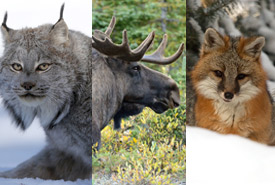World Wildlife Day Round 2: Vote for your favourite mammal species

World Wildlife Day: vote for Canada lynx (photo by Mike Dembeck) ,moose (photo by Paul Turbitt) or gray fox (photo by John James Henderson)

World Wildlife Day: vote for Canada lynx (photo by Mike Dembeck) ,moose (photo by Paul Turbitt) or gray fox (photo by John James Henderson)